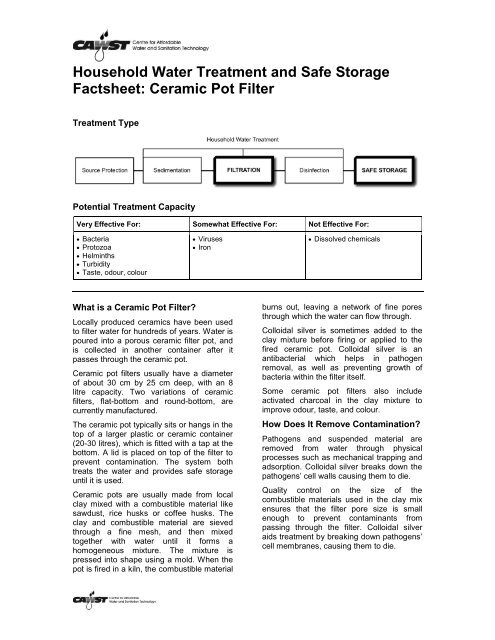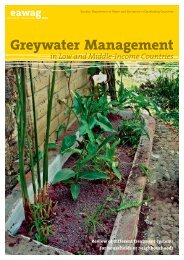Household Water Treatment and Safe Storage Factsheet: Source ...
Household Water Treatment and Safe Storage Factsheet: Source ...
Household Water Treatment and Safe Storage Factsheet: Source ...
Create successful ePaper yourself
Turn your PDF publications into a flip-book with our unique Google optimized e-Paper software.
<strong>Household</strong> <strong>Water</strong> <strong>Treatment</strong> <strong>and</strong> <strong>Safe</strong> <strong>Storage</strong><br />
<strong>Factsheet</strong>: Ceramic Pot Filter<br />
<strong>Treatment</strong> Type<br />
Potential <strong>Treatment</strong> Capacity<br />
Very Effective For: Somewhat Effective For: Not Effective For:<br />
Bacteria<br />
Protozoa<br />
Helminths<br />
Turbidity<br />
Taste, odour, colour<br />
Viruses<br />
Iron<br />
Dissolved chemicals<br />
What is a Ceramic Pot Filter?<br />
Locally produced ceramics have been used<br />
to filter water for hundreds of years. <strong>Water</strong> is<br />
poured into a porous ceramic filter pot, <strong>and</strong><br />
is collected in another container after it<br />
passes through the ceramic pot.<br />
Ceramic pot filters usually have a diameter<br />
of about 30 cm by 25 cm deep, with an 8<br />
litre capacity. Two variations of ceramic<br />
filters, flat-bottom <strong>and</strong> round-bottom, are<br />
currently manufactured.<br />
The ceramic pot typically sits or hangs in the<br />
top of a larger plastic or ceramic container<br />
(20-30 litres), which is fitted with a tap at the<br />
bottom. A lid is placed on top of the filter to<br />
prevent contamination. The system both<br />
treats the water <strong>and</strong> provides safe storage<br />
until it is used.<br />
Ceramic pots are usually made from local<br />
clay mixed with a combustible material like<br />
sawdust, rice husks or coffee husks. The<br />
clay <strong>and</strong> combustible material are sieved<br />
through a fine mesh, <strong>and</strong> then mixed<br />
together with water until it forms a<br />
homogeneous mixture. The mixture is<br />
pressed into shape using a mold. When the<br />
pot is fired in a kiln, the combustible material<br />
burns out, leaving a network of fine pores<br />
through which the water can flow through.<br />
Colloidal silver is sometimes added to the<br />
clay mixture before firing or applied to the<br />
fired ceramic pot. Colloidal silver is an<br />
antibacterial which helps in pathogen<br />
removal, as well as preventing growth of<br />
bacteria within the filter itself.<br />
Some ceramic pot filters also include<br />
activated charcoal in the clay mixture to<br />
improve odour, taste, <strong>and</strong> colour.<br />
How Does It Remove Contamination?<br />
Pathogens <strong>and</strong> suspended material are<br />
removed from water through physical<br />
processes such as mechanical trapping <strong>and</strong><br />
adsorption. Colloidal silver breaks down the<br />
pathogens’ cell walls causing them to die.<br />
Quality control on the size of the<br />
combustible materials used in the clay mix<br />
ensures that the filter pore size is small<br />
enough to prevent contaminants from<br />
passing through the filter. Colloidal silver<br />
aids treatment by breaking down pathogens’<br />
cell membranes, causing them to die.
















